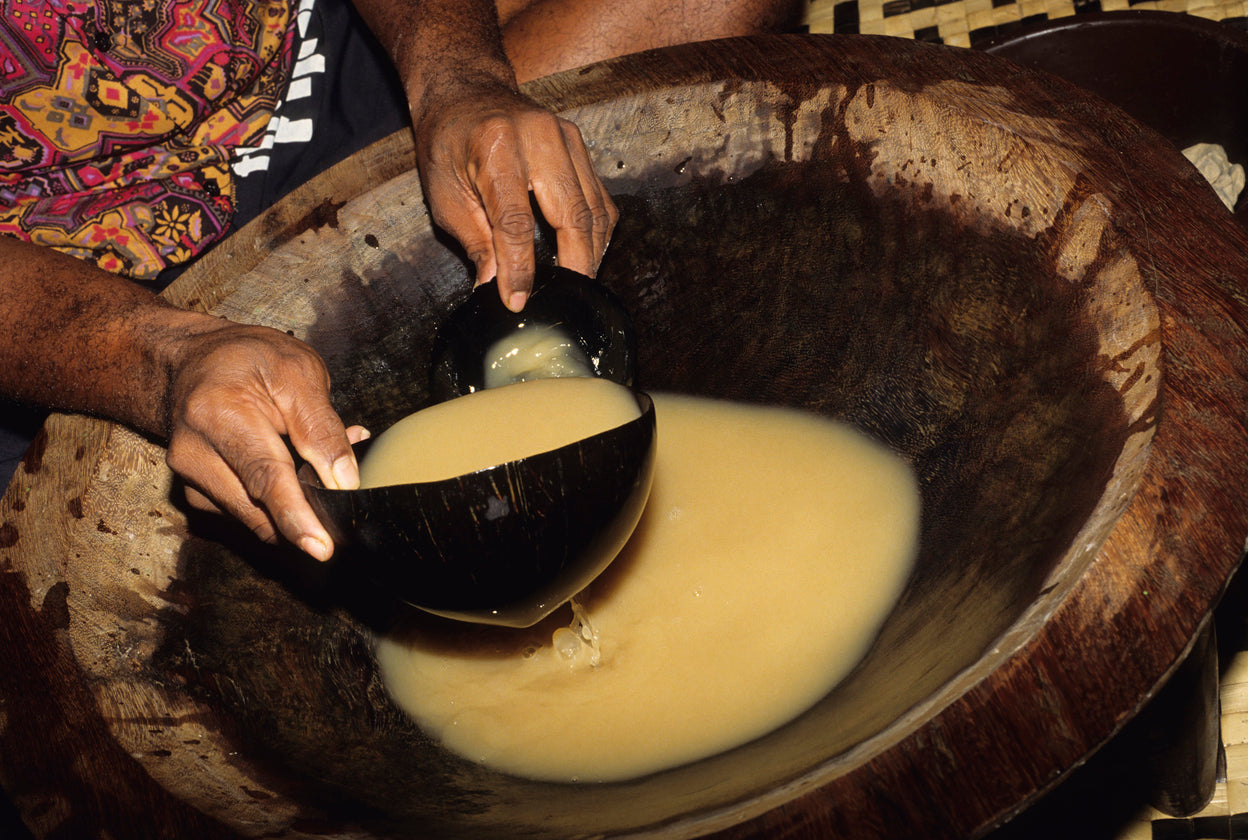
What may seem like a simple wooden bowl to some, the kava bowl has deep rooted meaning in traditional kava drinking.
Various cultures within the Pacific Islands have similar respect for the kava bowl. Small factors may change among cultures, like the name of it or how many legs it has. But overall, it adds significant value to the process of drinking and sharing kava.
Origin of the Name
For centuries, natives in the Pacific Islands have been drinking kava before ceremonies and rituals. Kava is prepared using the root of the piper methysticum plant, a member of the pepper family. The kava root is pounded into a powder and then mixed with water.
In ancient times, preparation was done by young women who would chew the root, mixing it with their saliva, and spitting it into the bowl.
The bowl, then being referred to as the kava bowl, is then passed around in a specific order and etiquette set forth by the villagers. For example, the bowl belonging to the chief of the village is usually the one passed around at the event.
Tanoa is the local name for kava bowl. It is the name used most often by Pacific Islanders. Others call it a laulau.
They are made from a single piece of wood, usually from the ifilele tree that has a reddish-brown color. Hardwood trees are the most commonly used among all the cultures. After the bowl is carved, it is soaked in water for a long while so that it doesn’t smell like wood. Tanoa are always similar in shape.

Shape
Kava bowls are usually round or elliptical. The rims are shallow and it sits on several legs. The number of legs can range from four up to twenty or more. Some elliptical bowls do not have legs at all.
Elliptical bowls are usually used by families. The round and often larger bowls are used for groups at ceremonies or rituals. The round bowls were usually owned by chiefs and it was quite an honor to be drinking from them.
The bowl itself varies in size but is consistently shallow. It would be rare to find a kava bowl deeper than six inches.
A suspension lug is seen on all kava bowls. It rests between a pair of legs and usually forms a “v” shape or a “t” shape. Legs are short, measuring up to four inches. The legs are usually larger at the top and narrow at the bottom.
Holes are often drilled in the suspension lugs that allow a cord or some kind to be strung through two holes. This cord is used for hanging the bowl in between uses.
Carvings and Decorations
Kava bowls used by natives are simply made, without carvings and decorations. When the islanders realized tourists wanted the more ornate versions, the native islanders capitalized and began producing colorful, decorated bowls to sell to tourists.
Originally, tourists were charged by the number of legs on the kava bowl. In more modern times, kava is consumed using a variety of cups and bowls. However, wooden bowls are still used today when drinking kava before, during or after ceremonies and rituals.
Rituals and Ceremonies
Drinking kava involves a certain etiquette, complete with chants, prayers and body movements. A prayer blessing must occur over the kava bowl and drink before consuming it. The blessings are then followed by two or more claps, which are the villager’s way of showing respect.
Those who will be drinking kava will then receive a bilo, or a brown cup made from the shell of a coconut.
Often, the leaders of the village will drink first and then pass the kava to the next person. Each person will clap and say, “Bula” before they drink and clap several times after they take a drink.
Kava is consumed before important ceremonies and events. Most believe kava is a spiritual symbol, allowing those who drink kava to be able to communicate with the spirit gods. There are many who debate this theory, however, saying that it calls up demons instead.
During the preparation of the kava, dancing takes place. There may also be dance like movements performed by what some call the protectors of the Tongan royal family.
Kava traditionally has been known as a drink that brings people together socially and for good outcomes. It represents the resolutions of problems, seeking peace to restore goodwill among all.

Complimentary Tools
The kava bowl is often accompanied by a cup and a strainer. The strainer is used after mixing water and kava root powder to gather the liquid remains of the mixture. The cup is often made from the shell of a coconut and is used to scoop kava mixture into the bowl.
These can be substituted with more modern-day utensils, or you can purchase kava in ready to use mixes supplied by wholesalers.
Suppliers and wholesalers can also supply you with a modern bowl. If you are seeking a used, well-worn bowl, you may have to search online for antiques and collectibles. Traditional style strainer bags and coconut shell cups can also be found for sale online.
Kava making would not be as important without the kava bowl. It is this bowl that holds the liquid that represents the meaning behind each ceremony or ritual.
The kava bowl is just as necessary as the actual kava root used to form the liquid stored in the bowl. Of course, anyone can drink kava from any type of vessel. But the traditional methods of drinking kava clearly value the use of the bowl.
The bowl has changed over the last three thousand years. From a simple hand-carved wooden bowl to plastic or metal, they have adapted for the times. While you can still purchase traditional style bowls, most people today opt for modern drinking cups.
The key behind the kava bowl is the sharing that takes place among all men and women participating in the ritual. It is the camaraderie, the connection and the gathering of a group where everyone wants to feel happy and sociable.
The kava bowl, because it is passed around and shared, helps people make that connection and begin spreading cheerful good will for all.
